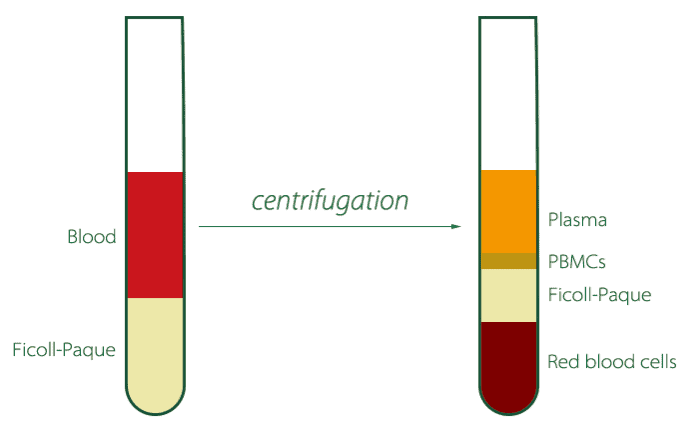- In-Stock Tumor Cell Lines
- Human Orbital Fibroblasts
- Human Microglia
- Human Pulmonary Alveolar Epithelial Cells
- Human Colonic Fibroblasts
- Human Type II Alveolar Epithelial Cells
- Human Valvular Interstitial Cells
- Human Thyroid Epithelial Cells
- C57BL/6 Mouse Dermal Fibroblasts
- Human Alveolar Macrophages
- Human Dermal Fibroblasts, Adult
- Human Lung Fibroblasts, Adult
- Human Retinal Muller Cells
- Human Articular Chondrocytes
- Human Retinal Pigment Epithelial Cells
- Human Pancreatic Islets of Langerhans Cells
- Human Kidney Podocyte Cells
- Human Renal Proximal Tubule Cells
What is Peripheral Blood Mononuclear Cells (PBMCs)?

Peripheral Blood Mononuclear Cells (PBMCs), also known as Human Mononuclear Cells from Peripheral Blood (HMNC-PB), originate from Hematopoietic Stem Cells (HSCs), which reside in the bone marrow.
Through the process of hematopoiesis, HSCs generate all types of blood cells of the immune system, which are typically divided into two branches: myeloid and lymphoid. Myeloid cells include monocytes, erythrocytes, macrophages, neutrophils, basophils, eosinophils, and megakaryocytes to platelets. Lymphoid cells include T cells, B cells, Natural Killer (NK) cells, and innate lymphoid cells. Among those cells, there are single-nucleus cells, multiple-nuclei cells, and non-nucleated cells.
PBMC is a group of above-mentioned blood cells that only possess a single and round nucleus instead of one single type of cells. Thus, PBMC could give selective immune responses in different situations depending on the reactive cells. Those cells are the major cells in the human immune system and vital to human body immunity.
What is included in PBMC Fraction?
There is a wide range of cell types in Peripheral Blood Mononuclear Cells (PBMCs). In general, peripheral blood mononuclear cells consist of monocytes, dendritic cells, as well as lymphoid lineages including T cells, B cells, and NK cells. Generally, lymphocytes make up about 70-90% of PBMC population, monocytes 10-20%, while dendritic cells only occupy about 1-2% of PBMC population. Thereinto, CD3+ T cells make up 70-85% of lymphocyte population, NK cells 5-20% and B cells 5-10%. And there are two subsets in a 2:1 ratio within CD3+ lymphocytes, which are CD4+ T cells and CD8+ T cells.
The detailed cell populations in PBMCs are shown in following chart. Frequencies of these cell populations vary across individuals.

Cell Populations in PBMCs
How to efficiently isolate PBMCs?
Peripheral Blood Mononuclear Cells (PBMCs) are collected from the peripheral or circulating blood. And there are two principal techniques to collect PBMCs.
Density gradient centrifugation is the method that separates particles based on size, shape and density, using gels or solutions of different densities. Based on the principle that during under a centrifugal force, denser particles move to the periphery whereas the less dense molecules move towards the center. Molecules would settle down until they reach the medium of which the density is as same as theirs. Then the sample in the centrifuge tube will be separated into well-defined layers, which enables the extraction more effortless.
The frequently-used solution to separate PBMC is Ficoll or Ficoll-Paque, containing sodium diatrizoate, polysaccharides and water. The density of this medium is 1.08g/mL, larger than erythrocytes but smaller than plasma. Thus, after centrifugation, the blood sample would be separated into three layers: a layer of clear fluid (the plasma) at the top, a layer of red fluid containing most of the red blood cells at the bottom, and the PBMC fraction will appear as a thin white layer in between. This highly pure population of cells makes them ideal for further isolations of specific cell types within the PBMC fraction.

Leukapheresis is a specially modified apheresis technique designed to separate out leukocytes from the inflow of the blood and return the remainders (i.e., granulocytes, platelets, red blood cells) to the bloodstream of the patient or donor.
Compared to density gradient centrifugation, leukapheresis is a more efficient way to separate PBMCs from peripheral blood or circulating blood. On average, PBMC collection from leukapheresis is 14 times more than that through the density gradient centrifugation. Therefore, Leukopak (LP), the leukapheresis sample, becomes the rich source of PBMCs as it makes large-scale research studies and pre-clinical trials on PBMC much easier.
Cells can be either used immediately or frozen for long-term storage.
Applications
As mentioned above, PBMCs give selective responses to the immune system. They are widely used in immunology, hematological malignancies, infectious disease, vaccine development, transplant immunology. Peripheral blood is the place exposed to chemicals, so that PBMCs are prone to be influenced by drugs and chemicals. This is the reason that the availability of PBMCs from peripheral blood is very important for researchers studying toxicity of new drugs or chemical compounds.
Besides, PBMCs can also be used in high-throughput screening, proteomics, toxicology and pre-clinical research. Cryopreserved PBMCs can be used for positive and negative controls for T-cell monitoring in ELISPOT, ELISA, cytokine bead array, tetramer/pentamer, and flow cytometry assays.
AcceGen PBMC
PBMCs are important source of clinical studies related to human health and disease. AcceGen PBMCs are now readily available from a number of commercial sources, with samples isolated from both healthy and diseased individuals. Over 300 different lots are available right now. AcceGen PBMCs are cryopreserved immediately after isolation and stored in frozen vials.
AcceGen offers PBMC products and keeps the inventory updated to meet customers’ needs. For more information about PBMCs or any other AcceGen products, please call us at 1-862-686-2696 or send an email to [email protected]. Your questions and requests will be answered by expert staff in AcceGen within 24 hours.

Copyright - Unless otherwise stated all contents of this website are AcceGen™ All Rights Reserved – Full details of the use of materials on this site please refer to AcceGen Editorial Policy – Guest Posts are welcome, by submitting a guest post to AcceGen you are agree to the AcceGen Guest Post Agreement – Any concerns please contact [email protected]








